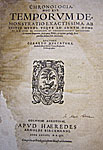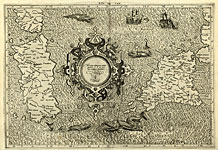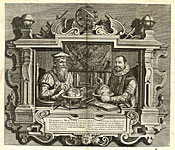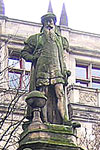500th Anniversary of Gerardus Mercator
Atlas
After 1569, Mercator began to pursue the main dream of his life - producing an universal Cosmography which was to consist of five parts dealing with the creation of the world, the description of celestial objects, earth and seas, genealogy and history of nations, chronology. This grandiose plan was partly fulfilled. In 1569, he published the Chronology, which laid the foundation for the other parts. It included a chronological list of political, cultural, scientific and biblical events, as well as tables of solar and lunar eclipses. Subsequently, the book was banned by the Church, because it contained information related to Martin Luther and a few other heretics.Then Mercator published his version of Claudius Ptolemy's maps as a source for ancient geography.
In 1585 and 1589 years, he issued two volumes devoted to several countries in Europe, and that was the last lifetime editions of the great cartographer. By the end of the life, Mercator had two strokes and could not move independently, on 2 December 1594, he died.
Continuing his father's work, in 1595, his son Rumold issued a full version of the Atlas, which comprised a treatise on the creation of the world, a biography of Mercator, as well as 107 cards, 102 of which were engraved by Mercator himself. It should be noted that the collections of the maps, earlier produced by other authors, were called differently: the "Theater of the World," "Мирror of the World," etc. But Mercator was the first to name a book of maps: "Atlas, or Cosmographic Meditations on the Creation of the World and the Form of Creation", thus coining the term Atlas which is familiar to us from school.
Especially interesting is Map of Russia, included in the atlas. This was not the first map of this country in the European cartography, but the most accurate and detailed for its time.
In 1602, the heirs of Mercator undertook another edition of the Atlas, and, in 1604, the copper plates of all his maps were sold to the successful Amsterdam publisher Jodocus Hondius the Elder. He added new maps and continued to publish Mercator's Atlas in two forms: as a large fundamental Atlas and its miniature "pocket" version (the Atlas Minor). The text of the Atlas was translated into several European languages, this made it very popular. The Hondius-Mercator reduced atlas was reprinted dozens of times.
In 1639, Jan Jansson, Hondius' son-in-law, took over the business. He continued to release atlases of the world using the plates developed by his father-in-law and Gerard Mercator, but removed their names from the title page and maps.
A peculiar interpretation of Mercator's Atlas was made in Russia. In 1637, by order Tsar Mikhail Fyodorovich, the members of the Ambassadorial Office Bogdan Lykov and Ivan Dorn translated the Atlas into Russian and gave it the title: "The Book Called Cosmography that is a description of the world and great countries". About Mercator, translators spoke with great respect, 'In this day, Gerardus Mercator depicts the whole world more precisely that all the previous authors ; this Gerardus, worthy of praise, has divided the entire great world into three parts'. Later, Cosmography formed the base for the famous Cosmography in Seventy Six Chapters (Semidesyatishestiglavaya Kosmografia) which compiled all the best and interesting geographical information from various foreign sources. This hand-written work was published in the 80s of the 19th century.
G.Mercator's anniversary was widely celebrated by the global scientific community. Monuments of Mercator were constructed in many European cities. His name was given to an observatory in South America, ships and international trains. On the eve of the anniversary date, a commemorative 100 euro coin was minted and issued by Belgium.








![Atlas Minor. Arnhem, [1607]](images/22_sm.jpg)


